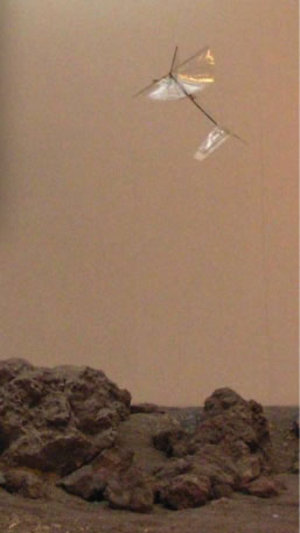This is perhaps the coolest thing I've ever seen. Ray Villard, the news director for the Hubble Space Telescope, also writes a blog for Discovery called Cosmic Ray (love that name!) He recently wrote about a dragonfly-like robotic device being developed by the Technical University Delft, Wageningen University in the Netherlands. It's call the ExoFly, and Ray described it as a "dragonfly-on-steroids ... a nimble flapping aerobot." It could be the next generation of robotic planetary explorers. It's a small, lightweight autonomous machine capable of flying, hovering, landing and taking off like an insect. Ray says this type of vehicle would "open up a new exploration niches that it not easily reachable by rovers or airborne vehicles on far flung worlds." Actually, it might work best in conjunction with a future big rover, flying ahead to search for interesting or dangerous terrain, and the rover would provide a "landing pad" for the ExoFly's home base. While the ExoFly may be small, its name sounds like a potential super hero, and its capabilities could be in the exploration super hero category, as well.
Take a look at the incredible video of the ExoFly below:
The ExoFly would be great for exploring Mars, and Titan, too. Small onboard cameras would provide a unique overhead but close-up view of the terrain in geological terms that would be different from, and could compliment, a rover.
The prototype ExoFly weighs less than an ounce, has a wingspan of only a foot, and can fly for 12 minutes on batteries.
A Mars ExoFly would need a longer wingspan and carry a miniaturized high-resolution digital video camera, sensors, navigation system and instruments.
Check out all of Ray Villard's ideas for this future flying robot at Cosmic Ray.
Image and video credit: T.E. Zegers
Source: Cosmic Ray (with a head nod to Disco Dave Mosher for his Twitter Tweet)
 Universe Today
Universe Today
